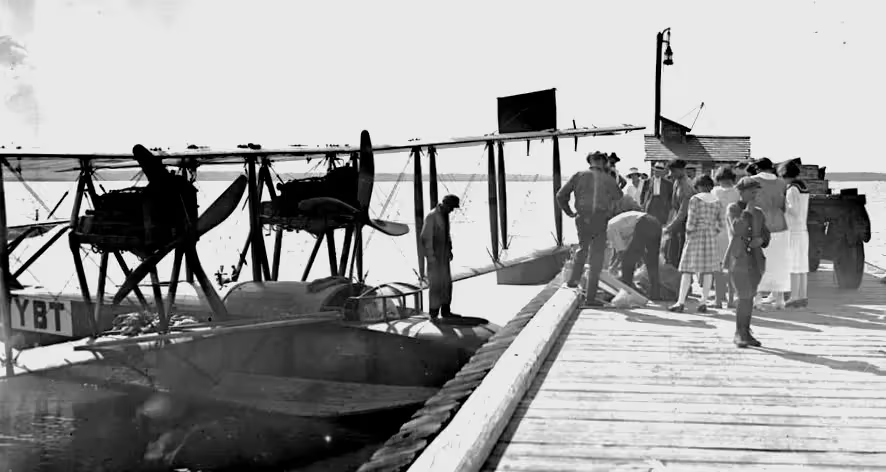Canadian Warplanes 1: Felixstowe F.3 and F.5 Flying Boats
Felixstowe F.3 Flying Boats

(Library and Archives Canada Photo, MIKAN No. 3580743)
Felixstowe F.3, Reg. No. G-CYDI, Jericho Beach, British Columbia, c1923. G-CYDI was the only Felixstowe on the West coast.
The Felixstowe F.3 was a British First World War flying boat, successor to the Felixstowe F.2 designed by Lieutenant Commander John Cyril Porte RN at Felixstowe Naval Air Station in the UK. In February 1917, the first prototype of the Felixstowe F.3 was flown. This was a larger and heavier development of the Felixstowe F.2A, powered by two 320 hp (239 kW) Sunbeam Cossack engines. Large orders followed, with the production aircraft powered by Rolls-Royce Eagles. The F.3's larger size gave it greater range and a heavier bombload than the F2, but poorer speed and agility. Approximately 100 Felixstowe F.3s were produced before the end of the war. (Wikipedia)
Felixstowe F.3 (11) Reg. Nos. G-CYBT, DH-DJ, DQ, EN, EO, N4012 (later G-CYDI), 13, N4178, 79.

(Library and Archives Canada Photo, MIKAN No. 3390396)
Felixstowe F.3 flying boat G-CYBT of the Canadian Air Board, The Pas, Manitoba, 1921.
On 6 June 1919, the Canadian government passed the Air Board Act, authorizing a 7-member board to regulate and control all aeronautics in Canada. The Air Board was to form three divisions: a Civil Aviation Branch for the control of commercial and civil flying, a Civil Operations Branch in charge of all non-military flying operations, and a Canadian Air Force (CAF) primarily responsible for training, rather than defence. The first Air Board was constituted by an Order-in-Council on 23 Jun 1919. Four Felixstowe F.3 flying boats, 18 Curtiss HS-2L flying boats, 11 de Havilland DH.4 landplanes and three Avro Viper seaplanes were employed on forest fire patrols, anti-smuggling patrols, treaty money flights to First Nations and general communications and transport work.
In 1920, the Canadian Air Board sponsored a project to conduct the first-ever Trans-Canada flight to determine the feasibility of such flights for future air mail and passenger service. The leg from Rivière du Loup to Winnipeg was flown by Lieutenant Colonel Leckie and Major Hobbs in a Felixstowe F.3.

(Library and Archives Canada Photo, MIKAN No. 3575583)
Air Marshall Robert Leckie, CB, DSO, DSC, DFC, CD (16 April 1890 – 31 March 1975) was an air officer in the RAF and the Chief of Staff of the RCAF from 1944 to 1947. He initially served in the Royal Naval Air Service (RNAS) during the First World War, where he became known as one of "the Zeppelin killers from Canada", after shooting down two airships. During the inter-war period he served as an RAF squadron and station commander, eventually becoming the RAF's Director of Training in 1935. He also served as the Air Officer Commanding RAF Mediterranean from 1938 until after the beginning of the Second World War. In 1940 he returned to Canada where he was primarily responsible for the British Commonwealth Air Training Plan, transferring to the RCAF in 1942. The photo was taken in 1919.

(Library and Archives Canada Photo, MIKAN No. 3390395)
Felixstowe F.3 flying boat G-CYBT of the Air Board, Pelican Narrows, Saskatchewan, 1922.

(Library and Archives Canada Photo, MIKAN No. 3390402)
Felixstowe F.5 flying boat built by Canadian Aeroplanes Ltd. Toronto, Ontario, July 1918.

(Library and Archives Canada Photo, MIKAN No. 3368780)
Felixstowe F.5 Flying Boat Hull with Liberty Engines in position, Canadian Aeroplanes Ltd., Toronto, Ontario, 1918.

(Library and Archives Canada Photo, MIKAN No. 3394773)
Felixstowe F.5 flying boat on a parade float, London, 19 Nov 1918.

(Library and Archives Canada Photo, MIKAN No. 3390394)
Felixstowe F.3 flying boat G-CYBT of the Canadian Air Board, Pelican Narrows, Saskatchewan, 1922.

(Library and Archives Canada Photo, MIKAN No. 3200383)
Felixstowe F.3 flying boat G-CYEN, Canadian Air Board, engine change, 8 Aug 1922.

(Library and Archives Canada Photo, MIKAN No. 3575578)
Felixstowe F.3 flying boat of the Canadian Air Board, 5 Sep 1921.

(Library and Archives Canada Photo, MIKAN No. 3389980)
Felixstowe F.3 flying boat of the Canadian Air Board, c1921.

(Library and Archives Canada Photo, MIKAN No. 3390399)
Felixstowe F.5 flying boat built by Canadian Aeroplanes Ltd. Toronto, Ont. July 1918.

(Library and Archives Canada Photo, MIKAN No. 3643589)
Felixstowe F.3 flying boat G-CYBT of the Air Board, Victoria Beach, Manitoba, 5 Aug 1921.

(Library and Archives Canada Photo, MIKAN No. 3575583)
Loading supplies aboard a Felixstowe F.3 flying boat of the Canadian Air Board, 14 Aug 1921. The F.3 This was larger and heavier than the F.2, giving it greater range and heavier bomb load, but poorer agility. Approximately 100 Felixstowe F.3s were produced before the end of the war.

(Library and Archives Canada Photo, MIKAN No. 3580751)
Felixstowe F.2A flying boat. The Felixstowe F.2A was used as a patrol aircraft over the North Sea until the end of the war. Its excellent performance and maneuverability made it an effective and popular type, often fighting enemy patrol and fighter aircraft, as well as hunting . The larger F.3, which was less popular with its crews than the more maneuverable F.2A, served in the Mediterranean and the North Sea.
The F.5 did not enter service until after the end of the First World War, but replaced the earlier Felixstowe boats (together with Curtiss flying boats) to serve as the RAFs standard flying boat until

(Library and Archives Canada Photo, MIKAN No. 3370973)
Felixstowe F5 Flying Boat being built by Canadian Aeroplanes Ltd., Toronto, Ontario, 15 July 1918.

(Library and Archives Canada Photo, MIKAN No. 3368781)
Felixstowe F5 Flying Boats being boxed for shipment by Canadian Aeroplanes Ltd., Toronto, Ontario, 1918.





